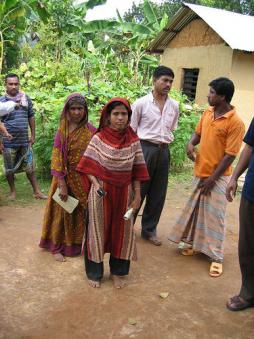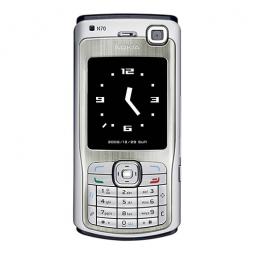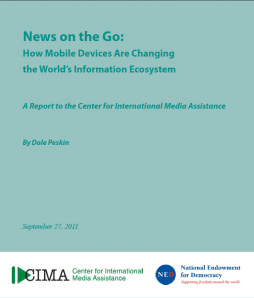Communications Access and Infrastructure
Posted by KatrinVerclas on Sep 19, 2007
Grameen Foundation's Village Phone program has long been touted as the poster child for using mobiles in the economic empowerment of poor women. The program gives villagers in Bangladesh-- and now in several other countries -- access to microcredit to buy a mobile phone that can then be rented to other villagers who do not have a mobile of their own.
Much has been written about Village Phones in the media and in research reports, often describing in glowing terms the economic impact and gain in social status that the women in the program have achieved. Yet, most of these studies are fairly old at this point, predating the exponential growth of mobiles around the world.
Now questions are being raised in some mainstream media about whether renting out minutes on mobile phones is economically beneficial to the so-called village phone operators -- at a time when mobiles have become so much more ubiquitous, even in remote rural areas.
Posted by KatrinVerclas on Mar 05, 2007
Gerry Jackson reports on Media Helping Media about the radio station SW Radio Africa outsisde of London that is sending sms headlines about news in Zimbabwe to it's subscriber base of about 2,000 mobile users. Jackson writes:
"We generate news headlines on a daily basis anyway - so this is just another way of using what already exists.
It’s nice and cost effective for any additional donor because there is only the one cost, actually sending the texts. In two months we’ve built up an address database of about 2,000 mobile phone numbers. Like many, Zimbabweans truly love their mobile phones and of course what we’re banking on is the virus effect.
We also get up to 100 requests a day to be added to the service so it’s growing rapidly. What becomes interesting is what business model to use?
Posted by EKStallings on Dec 19, 2011
Beyond ICT4D: New Media Research in Uganda data sheet 648 Views
Author:
Balunywa , Ali, Guido van Diepen, Wouter Dijkstra, Kai Henriquez, Ben White
Abstract:
This paper is a collection of five ethnographic reports examining the role of ICT in Uganda. The first is not particulalrly mobile focused and looks at how those who have access to internet in Uganda use it. The second report is about the ways ICT is changing print media. The third report focuses on the the opportunities ICT present for civil society and non-governmental groups. The next report outlines the way the ICT sector in Uganda was developed. The last report examines ways that ICT may be used in government accountability.
Posted by ccarlon on Dec 08, 2011
Using mLearning and MOOCs to Understand Chaos, Emergence, and Complexity in Education data sheet 589 Views
Author:
deWaard, Abajian, Gallagher, Hogue, Keskin, Koutropoulos, and Rodriguez
Abstract:
In this paper, we look at how the massive open online course (MOOC) format developed by connectivist researchers and enthusiasts can help analyze the complexity, emergence, and chaos at work in the field of education today. We do this through the prism of a MobiMOOC, a six-week course focusing on mLearning that ran from April to May 2011. MobiMOOC embraced the core MOOC components of self-organization, connectedness, openness, complexity, and the resulting chaos, and, as such, serves as an interesting paradigm for new educational orders that are currently emerging in the field. We discuss the nature of participation in MobiMOOC, the use of mobile technology and social media, and how these factors contributed to a chaotic learning environment with emerging phenomena. These emerging phenomena resulted in a transformative educational paradigm.
Posted by AnneryanHeatwole on Dec 02, 2011
It may be the end of the year, but that doesn't mean mobile events are slowing down! With conferences, calls for research, developer meet-ups, and networking opportunities, you won't get bored this December. Check out what's happening with mobiles this month:
- 5 December, Mobile Monday Las Vegas (Las Vegas, USA) The inaugural Las Vegas Mobile Monday meeting will feature presentations of mobile applications, product demonstrations, and discussions about social media outreach and investing.
- 5-7 December, mHealth Summit (Washington, D.C., USA) The third year of the mHealth Summit looks at how multiple sectors (including governments, NGOs, the telecommunications industry, and academia) can work together to create mobile health projects that improve health systems around the world. We'll be reporting from there.
- 6 December, The Guardian Mobile Business Summit 2011 (London, UK) This event focuses on the business side of mobile use – branding, user engagement, content creation and delivery, and mobile advertising. The event also has a large focus on networking for attendees.
- 6-9 December, MobiQuitous 2011 (Copenhagen, Denmark) For researchers and practitioners in the mobile and computing worlds, MobiQuitous offers a chance to share research and learn from workshops and discussions.
Posted by ccarlon on Nov 22, 2011
Asia Pacific Mobile Observatory 2011: Driving Economic and Social Development through Mobile Broadband data sheet 453 Views
Author:
Menon, Naveen and Christopher Firth
Abstract:
Asia Pacific is the largest mobile market in the world, and is continuing to show strong growth. Asia Pacific accounts for half of the total mobile connections in the world, with 3 billion lines. Looking ahead, the region is expected to continue its strong growth, adding a further 1.5 billion connections between 2010 and 2015 – similar in scale to the achievements of the last five years when 1.7 billion new connections were added. This growth and scale is encouraging for consumers and investors alike, as the industry has shown resilience through the global economic crisis by continuing to invest funds to improve the quality of mobile services across the region.
The 2011 Asia Pacific Mobile Observatory updates and expands on the first Asia Pacific Mobile Observatory carried out in 2009. With new data, analysis and insight it provides a comprehensive reference point for participants in the mobile industry, policy makers and other interested stakeholders.
This year’s report focuses especially on the positive economic and social impact of mobile broadband, which is having a transformative effect across Asia Pacific. The innovative Mobile Broadband Readiness Index aims to show how the AP17 countries compare against one another from a ‘readiness’ perspective and identify the means to sustain growth from a market, regulatory policy and corporate strategy perspective.
Posted by ccarlon on Nov 22, 2011
The Developmental Contribution from Mobile Phones Across the Agricultural Value Chain in Rural Africa data sheet 654 Views
Author:
Furuholt, Bjorn and Edmund Matotay
Abstract:
The most widespread information and communication technology (ICT) in developing countries today is the mobile phone. The majority of people in the least developed countries still live in rural areas and their livelihood depends on the primary industries. This study investigates the use of mobile phones among farmers in rural Tanzania in order to supply empirical data on the developmental role of this technology. The results show that the improved access to communication and information that mobile phones represent affects the entire cyclic farming life during the year and has resulted in considerable changes in the entire livelihood constructs, increased opportunities and reduced risks for rural farmer.
Posted by ccarlon on Nov 21, 2011
African Mobile Observatory 2011: Driving Economic and Social Development through Mobile Services data sheet 1693 Views
Author:
Page, Mark, Larurent Viviez, and Maria Molina
Abstract:
The Mobile Observatory series includes reports on the large and mature European market, the extensive and dynamically evolving market of the Asia-Pacific region and the fast growing Latin-American region. This is the first African edition in the GSMA Mobile Observatory series. This Observatory provides a comprehensive review of the African mobile communications industry. Included are the latest statistics and market developments, as a reference point for mobile industry participants, policy makers and other interested stakeholders. It covers the state of the industry, including the evolution of competition, innovation in new products, services and technologies and the industry’s contribution to social and economic development in Africa. The report integrates data from a wide range of existing sources to provide a comprehensive picture of the African mobile industry. These include public sources such as the ITU, World Bank and research by National Regulatory Authorities as well as commercial providers such as Wireless Intelligence, Informa, Gartner, Buddecomm and IDC.
The mobile industry in Africa is booming. With over 620 million mobile connections as of September 2011, Africa has overtaken Latin America to become the second largest mobile market in the world, after Asia. Over the past 10 years, the number of mobile connections in Africa has grown an average of 30% per year and is forecast to reach 735 million by the end of 2012. 3 Fierce competition has driven down prices and increased penetration. Price wars have been common across the continent as operators compete for market share with innovative revenue and pricing options - operators have reduced prices an average of 18% between 2010 and 2011, 4 making mobile connectivity more broadly affordable to the masses. 96% of subscriptions are pre-paid with voice services currently dominating, however the uptake of data services is increasing rapidly. For example in Kenya data revenues, including SMS, have increased at a remarkable 67% CAGR over the last 4 years and now represent 26% of total revenues.
For the mobile industry to continue to serve as a catalyst for growth, sufficient spectrum is needed for the provision of mobile broadband services. African countries have currently allocated considerably less spectrum to mobile services than developing countries in Europe, the Americas and Asia. Allocating the Digital Dividend spectrum to mobile services will enable the mobile industry to accelerate its efforts to bring connectivity and information to large swathes of rural Africa.
Posted by MarkWeingarten on Nov 18, 2011
The Mobile Financial Services Development Report 2011 data sheet 846 Views
Abstract:
The Mobile Financial Services Development Report 2011 assesses the development of the mobile financial services (MFS) ecosystem in twenty countries. Its purpose is to provide a tool for decision makers to identify relative areas of strength and weakness and to prioritize opportunities for collaborative action to build scale in mobile financial services. The Report defines mobile financial services development in terms of the key drivers across the institutional, market and end-user environments that lead to adoption and scale. Measures of mobile financial services development are captured across seven pillars:
1. Regulatory proportionality
2. Consumer protection
3. Market competitiveness
4. Market catalysts
5. End-user empowerment and access
6. Distribution and agent network
7. Adoption and availability
The Report thus takes a comprehensive view in assessing the factors that contribute to the long-term development of mobile financial services. It includes mobile payments and transfers within its scope but also the development of other vital financial services such as savings, credit, and insurance.
Posted by ccarlon on Nov 18, 2011
The Power of Social Media in Developing Nations data sheet 1164 Views
Abstract:
On January 28, 2011, Egypt’s President, Hosni Mubarak, took the drastic and unprecedented step of shutting off the Internet for five days across an entire nation. His reason for doing so was simple: to halt the flow of communication and coordinated assembly taking place over social media platforms, like Facebook and Twitter. That Mubarak took this desperate step — which cost Egypt an estimated $90 million and outraged the international community — demonstrates the incredible power of social media. Mubarak’s decision to shut off the Internet took place after three days of demonstrations by tens of thousands of Egyptians. Although the demonstrations were centered in Cairo’s Tahrir Square (or “Liberation Square”), there were also substantial demonstrations in Alexandria, Mansoura, and Suez. The protesters expressed outrage over several issues, including state corruption, police brutality, and economic oppression. Their demand was clear: President Hosni Mubarak must leave the country.
Various groups, including April 6 Youth Movement, We Are All Khaled Said, National Association for Change, and Kefaya led a coordinated effort using social media platforms, including Facebook and Twitter, to spread a revolutionary message. Prior to the first day of protest, 85,000 Egyptians pledged on Facebook to attend “Revolution Day.” Similarly, April 6 Movement had over 90,000 members during the protests, and We Are Khaled Said had over 40,000 Facebook fans. In the two weeks leading up to and including the first few days of the protest, Egyptians created 32,000 Facebook groups and 14,000 Facebook pages. It is likely that a substantial number of the five million Facebook users in Egypt were in some way encouraged to attend the protests.
Posted by VivianOnano on Nov 16, 2011
Are Mobile Phones Changing Social Networks? A Longitudinal Study Of Core Networks In Kerala data sheet 901 Views
Author:
Antony Palackal,Paul Nyaga Mbatia,Dan-Bright Dzorgbo,Ricardo B. Duque,Marcus Antonius Ynalvez,Wesley M. Shrum.
Abstract:
Mobile telephony has diffused more rapidly than any Indian technology in recent memory, yet systematic studies of its impact are rare, focusing on technological rather than social change. We employ network surveys of separate groups of Kerala residents in 2002 and again in 2007 to examine recent shifts in mobile usage patterns and social relationships.
Results show (1) near saturation of mobiles among both the professionals and nonprofessionals sampled, (2) a decrease in the number of social linkages across tie types and physical locations, and (3) a shift towards friends and family but away from work relationships in the core networks of Malayalis.
We interpret these findings as support for the bounded solidarity thesis of remote communication that emphasizes social insulation and network closure as mobiles shield individuals from their wider surroundings.
Posted by AnneryanHeatwole on Nov 04, 2011
Again, there are plenty of upcoming mobile and tech conferences. Check out our listings for November 2011 below, and feel free to let us know about any other upcoming events on Facebook or Twitter.
- 1-2 November: AppsWorld (New York City, USA) AppsWorld is a two-track event; one for marketers and one for developers. The app developer track focuses on bringing together developers and entrepreneurs to learn about creating, distributing, and monetizing apps. The marketing track looks at how apps can be used by businesses as part of a marketing strategy.
- 2-4 November: Open Mobile Summit (San Francisco, USA) The Open Mobile Summit is focused on how mobile, Internet, and media technologies can be used in business. The year's event will look at a variety of subjects including mobile money, the use of video technologies, mobile evolution, and more.
- 6-9 November: AnDevCon (San Francisco, USA) Love Android? Then check out the Android developer conference, where you can meet up with other developers to take technical classes and workshop projects.
- 9-10 November: 14th Annual Africa Com (Cape Town, South Africa) This year's conference focuses on "advancing innovation and profitability for a digital Africa." The event will look at a wide variety of digital projects, from m-health, to rural telecoms, to mobile money, to operator strategies.
Posted by AnneryanHeatwole on Oct 27, 2011
Today's Mobile Minute brings you coverage on India's mobile growth, smartphones in Asia, the relationship between social media and mobile phones in America, Nokia's global sales report, and the rise of open data projects in the United Kingdom.
- Reuters reports that mobile subscriptions in India are on the rise; in August alone mobile phone operators added 7.34 million new subscribers, bringing the country's total number of mobile subscriptions to 865.71 million. However, now that roughly 70% of the country's population has a mobile phone, the number of new subscribers is rising more slowly than last year as the market becomes more saturated.
- The mobile and smartphone market in the Asia-Pacific region is growing rapidly, and Cellular News has the breakdown of current and projected sales: "The smartphone market is [...] expected to have healthy growth, with 24% share in total handset shipments in 2011, up from 17% in 2010. Smartphone shipments in Asia will see a significant growth of 56% in 2011, which indicates the growing demand for smartphones in emerging Asian markets. Smartphone shipments in Asian markets will see a boost for Android-based smartphones, with market share increasing to 52% in 2011, up from 16% in 2010. As a result, the combined market share of Samsung and HTC, the leading Android-based smartphone makers in Asia, will swell from 11% in 2010 to 24% in 2011."
Posted by ccarlon on Oct 24, 2011
Institutional Corruption and Election Fraud: Evidence from a Field Experiment in Afghanistan data sheet 1116 Views
Author:
Callen, Michael and James D. Long
Abstract:
Elections in developing countries commonly fail to deliver accountability because of manipulation, often involving collusion between corrupt election o�fficials and political candidates. We report the results of an experimental evaluation of Quick Count Photo Capture|a monitoring technology designed to detect the illegal sale of votes by corrupt election offi�cials to candidates carried out in 471 polling centers across Afghanistan during the 2010 parliamentary elections. The intervention reduced vote counts by 25% for the candidate most likely to be buying votes and reduced the stealing of election materials by about 60%.
Additionally, we investigate the role of corrupt institutions in facilitating election fraud by combining: (i) separate fraud measurements at three important stages of the election; (ii) rich data on the political connections of key parliamentary candidates; (iii) precise geographic coordinates of polling centers; and (iv) experimental variation from our evaluation. Interestingly, strong political candidates react to the intervention by substituting fraud spatially and weak candidates react by substituting temporally. We explain these results in the context of a theory of corrupt vote transactions in which the capacity of candidates to protect corrupt off�cials from prosecution determines equilibrium levels of spatial and temporal substitution
Posted by ccarlon on Oct 21, 2011
Information Economy Report 2011: ICTs as an Enabler for Private Sector Development data sheet 1198 Views
Author:
Fredriksson, Torbjörn, Cécile Barayre, Scarlett Fondeur Gil, Diana Korka, Rémi Lang, Thao Nguyen, Marta Pérez Cusó and Smita Barbattini.
Abstract:
The Information Economy Report 2011 demonstrates that effective use of information and communication technologies (ICTs) in both the private and the public sector can significantly contribute to and accelerate progress in private sector development (PSD).
Governments and their development partners should take a holistic and comprehensive approach to leveraging ICTs in PSD, although a review of PSD strategies indicates that this is often not the practice. Similarly, donor strategies often refer to the use of ICTs in PSD in a peripheral manner only, if at all. On its own, new technology will have limited effects on PSD. However, when carefully integrated into policies and processes, ICTs can reduce business costs, promote transparent, rules-based systems, and improve communication between the public and private sector.
Governments need to work with the private sector to create an investment climate and a business environment that encourage the use of ICTs within private firms as well as in government. The potential of ICTs can then be realized, through adequate infrastructure and skills, and a commitment by governments to making markets work effectively. In some areas, there is already considerable experience and evidence to guide policy initiatives. In other areas, where opportunities for ICTs to contribute to PSD have emerged only in the past few years (as in the case of mobile money services), more analysis and testing of different business models is needed to assess potential and identify best practices.
Posted by ccarlon on Oct 13, 2011
Blacknoise: Low-fi Lightweight Steganography in Service of Free Speech data sheet 1054 Views
Abstract:
Censorship of communications is a widespread, current practice in various countries with repressive governments in order to prevent or restrict speech; political speech in particular. In many cases state-run telecommunications agencies including those providing internet and phone service, actively filter content or disconnect users in defense of incumbents in the face of widespread criticism by citizens.
In this paper I present Blacknoise, a system which uses commodity low-cost mobile telephones equipped with cameras, and takes advantage of their lowfidelity, noisy sensors in order to enable embedding of arbitrary text payloads into the images they produce. These images can then be disseminated via MMS, Bluetooth, or posting on the Internet, without requiring a separate digital camera or computer to perform processing.
Posted by AnneryanHeatwole on Oct 13, 2011
Today's Mobile Minute brings you news about the decline of knock-off phones in China, mobile phone statistics in South Africa, the case for password protecting your mobile phone, challenges to mHealth projects in Africa, and new global mobile statistics.
- A new article from the L.A. Times looks at the fall in popularity of shanzhai (knock-off) phones in China, as shanzhai phones now represent only 7% of the Chinese market, down from 20% in 2007. The article says that the trend for buying brand-name phones is due to the greater availability of low-cost smartphones, and a preference for high-end features in smartphones that the knock-offs can not replicate.
- Nielsen Wire recently released a study on mobile use in South Africa, examining everything from network loyalty and social mobile use (such as downloading ringtones, wallpapers, and screensavers), to comparisons between mobile contracts and pre-paid phones and the use of SMS and mobile instant messaging services.
- Do you password protect your phone? Read Write Web reports that more than half of smartphone owners surveyed by Confident Technologies do not lock and password protect their phones. If your phone is stolen, lost, or confiscated then all of your personal data (including contacts in the address book, emails saved in your inbox, and log-ins for social media sites like Twitter and Facebook) stored on your phone could be compromised; using a password makes this information harder to access.
- PBS examines the hype around mHealth projects in the developing world, and whether mobile technologies are successful at managing health issues. The article looks at challenges to mHealth projects such as limited mobile access for beneficiaries, spotty network coverage, the high costs of large-scale projects, and the difficulty of maintaining charged phones.
Posted by ccarlon on Oct 12, 2011
ICTs for Democracy Information and Communication Technologies for the Enhancement of Democracy – with a Focus on Empowerment data sheet 690 Views
Author:
Association for Progressive Communications
Abstract:
Globally, huge investments are made in ICT as an undisputed and essential component of almost all activities – state and corporate. It is also an integral part of international development cooperation. The rapid spread of ICT – particularly the internet and mobile telephony – is making information available instantly and at low cost to a degree unprecedented in history. It can be used to seek, receive, create and impart information by anyone, at any time and for any purpose. The innovative use of the media has created new forms of citizen journalism which give space to a diversity of voices. In this way, ICT enhances freedom of expression and the right to information, and increases the possibilities for citizen´s participation in decision making processes.
This report examines the potential of information and communications technologies (ICTs) for advancing democracy and empowerment, with a special focus on Kenya, Tanzania and Uganda. Access to and the strategic use of ICTs have been shown to have the potential to help bring about economic development, poverty reduction, and democratisation – including freedom of speech, the free flow of information and the promotion of human rights. Based on signs of current democracy deficits in the case study countries, it is crucial that ICTs be made central to development cooperation and to approaches to advance democracy in the three countries.
Across both urban and rural populations, the predominant tool for communication is the mobile phone, while access to the internet is largely limited to urban areas. The high cost of international internet connectivity – itself a consequence of dependence on satellite connectivity in Uganda and Tanzania especially – means that even within urban areas internet connectivity is the purview of a small well-to-do elite.
Posted by ccarlon on Oct 12, 2011
The Roadmap for Privacy by Design in Mobile Communications: A Practical Tool for Developers, Service Providers, and Users data sheet 780 Views
Author:
Cavoukian, Ann and Marilyn Prosch
Abstract:
Privacy by Design is a concept that is virally spreading around the globe. The powerful concept of engineering privacy directly into the design of new technologies, business practices and networked infrastructure, in order to achieve the doubly-enabled pairing of functionality and privacy, has gained significant adoption by governments, researchers and industry, in any number of sectors. Now that the PbD paradigm has achieved this high level of acceptance, the next major question to be addressed is – how can PbD best be operationalized?
In this guidance document, we focus on the solutions presented by the panellists – in particular, the parties to which responsibility for the implementation of each were assigned. Distinct trends were noted in the types of solution associated with each party, and it became clear that the panellists’ responses could be collected into a practical tool for developers, service providers and users – a Roadmap for Privacy by Design.
Here, we begin by describing the necessity for such a tool in the mobile industry, and then detail the Roadmap, which begins with the Device Manufacturer, travels through the OS/Platform Developer, Service Provider, and Application Developer, and ends with the responsibilities assigned to Users themselves.
Posted by ccarlon on Oct 12, 2011
Mobile Communications in Zambia data sheet 784 Views
Abstract:
This report uses AudienceScapes data from a nationally representative survey of Zambia to focus on how people of various social groups access and use mobile communications. The report also showcases how the AudienceScapes survey data can help members of the development community to design and implement more effective programs in technological access, communications and information empowerment.
Beyond measuring basic access and use levels, this report works to answer several key research questions regarding the role of mobile phones in economic and social development in Zambia. These include but are not limited to; what is the potential for SMS-based information services as a development tool, is the mobile market beginning to reach disadvantaged parts of the population, what are the continued barriers to mobile phone access and use, who is using mobile money and is their greater market potential for these services?
Posted by ccarlon on Oct 11, 2011
“SMS for Life“: Use of stock information to improve supply chain data sheet 682 Views
Author:
Barrington, Jim, Olympia Wereko-Brobby and René Ziegler
Abstract:
Stock-outs of malaria treatments at the health facility level in many sub-Saharan African countries have been a persistent problem for many years. A stock-out is the unavailability of medicine at the health facility. In Tanzania, 93 % of the population are at risk for malaria infection. The number of malaria cases is estimated to be 11 million resulting into 60-80 thousand deaths per year or 220 deaths per day in Tanzania alone. The goal of the SMS for Life pilot project was to develop a flexible and scalable solution to bring up-to-date visibility of anti-malarials within the Tanzanian Public Health Sector with a potential to reduce or eliminate stock-outs of five drugs (four dosage forms of ACTs and Quinine Injectable) in all health facilities in a pilot sample of three districts.
Initiated and led by Novartis, a public-private partnership was established with the Roll Back Malaria Partnership, IBM, Vodafone and the Ministry of Health in Tanzania. This unique partnership developed a solution using mobile phones, SMS messages, internet and mapping technology to visualize weekly stock inventory of Artemisinin Combination Therapy (ACTs) and Quinine Injectable at 129 health facilities and 226 villages. Over the course of one year, the Project Team designed the system, created a data repository, trained key staff and implemented the solution for a 21-week pilot in three districts of Tanzania: Ulanga, Kigoma Rural and Lindi Rural. These districts are located in three different regions and supplied from different Zonal Stores with a catchment population of 1.2 million people.
Posted by AnneryanHeatwole on Oct 04, 2011
A new month brings new events, so check out everything that's happening in mobile-for-development land this October!
- 4-7 October STAR-TIDES Technology Demo (Washington, D.C., USA) This free Tech@State event "showcases innovative, low-cost, sustainable technologies for stressed populations, post-war, post-disaster, and impoverished [communities]." Visitors can interact with the technology and there will be live demonstrations throughout the event.
- 4-7 October Planet of the Apps Europe (London, UK) If you're looking for an event that focuses on the business side of mobile development, Planet of the Apps highlights mobile strategies and opportunities for developers, manufacturers, operators, and marketers.
- 6-7 October DroidCon UK (London, UK) Love Android? The latest DroidCon is a two-day event for Android developers; the first day features a community-led Barcamp and a democamp where developers can showcase their work and lead discussions, while the second day features presentations from top Android developers.
- 14-16 October Data Without Borders (New York City, USA) Do you have data you want analyzed? Data Without Borders is hosting a kickoff "datadive," a weekend of bringing together NGOs with data experts for free consultations and data analyzations.
- 18-20 October RIM DevCon Americans (San Francisco, USA) Want to learn how to develop for the BlackBerry platform? The two-day DevCon Americas is a "showcase for the latest innovations and breakthroughs with the BlackBerry Development Platform. Thousands of BlackBerry enthusiasts come together for sessions, demonstrations, hands-on labs and keynotes — all focused on creating mobile applications for the powerful BlackBerry platform."
- 27-28 October Tech4Africa (Johannesburg, South Africa) Tech4Africa looks at mobile, web, and emerging technology in Africa. The event has panel discussions, workshops, and Ignite pitches examining trends in technology and information, specifically for the African market.
Posted by MelissaUlbricht on Sep 30, 2011
A new report from the Center for International Media Assistance (CIMA) at the National Endowment for Democracy “examines questions about how a global information society might look with mobile media devices at its hub.” The report, News on the Go: How Mobile Devices Are Changing the World's Information Ecosystem, is available for download here.
According to the report, at the end of 2010, more than 4 billion people paid for mobile serivce. By the end of this year, about 5 billion mobile phones will be in service in a world with 7 billion people. The report suggests that the implications of so many people having access to phones are many: for politics, for education, for economies, for civil society, and for news and information.
While it offers several examples of mobile case studies in these various issue areas, the report focuses primarily on the growth of mobile Internet, and, hence, high-end smart phones over basic feature phones.
At MobileActive.org and on the Mobile Media Toolkit, we write often about the role of and potential for the basic feature phone. The CIMA report takes the stance that while 5 billion people will have access to mobile phones, by the end of this year “virtually every phone sold” will be a more high-end device.
Posted by AnneryanHeatwole on Sep 30, 2011
ICT4D and M4D projects often focus on how mobiles can be used in developing countries, but the success and usefulness of these projects depends on the value mobile users place on their phones, and how they use them. "We Use It Different, Different: Making Sense of Trends in Mobile Use in Ghana," looks at how Ghanians use mobile phones in their day-to-day lives, mainly focusing on why survey participants started using a mobile phone, how they use it, and how they view the value of mobile phone ownership.
| Featured Research: Making Sense of Mobile Phone Use in Ghana data sheet 1956 Views |
| Countries: |
Ghana
|
Posted by kelechiea on Sep 26, 2011
Texting, Tweeting, Mobile Internet: New Platforms for Democratic Debate in Africa data sheet 1748 Views
Abstract:
New media platforms are changing how people communicate with each other around the world. However, there is great variation in both the kind of
communication platforms people make use of as well as in how they access these platforms. Computer ownership and internet access are still the prerogative of the wealthy few in wide swathes of the African continent. All the same, mobile internet access is on the rise and if current growth rates continue, African mobile phone penetration will reach 100 per cent by 2014. Mobile phone penetration rates, in particular, have resulted in a plethora of ideas for new media platforms aimed at bridging the information divide between the well-connected and the disconnected. Topic areas range from agriculture and conservation to health and human rights. In addition to mobile phone-based platforms, there is also a number of promising internet-based ones.






